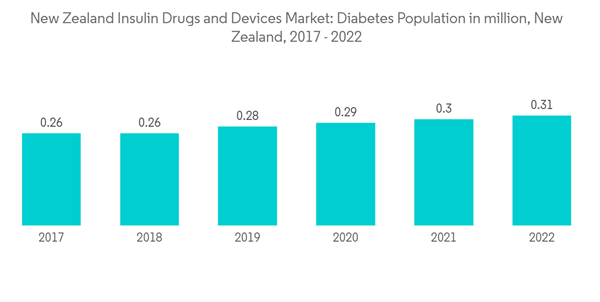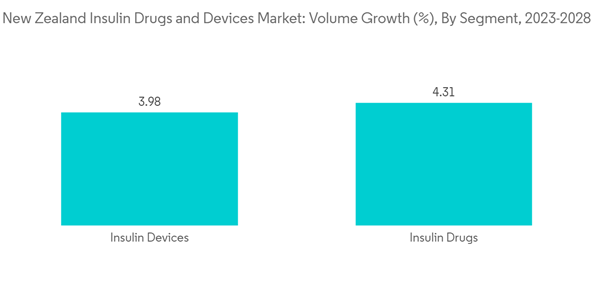The New Zealand Insulin Drugs and Devices Market size is estimated at USD 523.18 million in 2024, and is expected to reach USD 552.60 million by 2029, growing at a CAGR of 1.10% during the forecast period (2024-2029).
After COVID-19 was detected, the risk of developing type 1 diabetes increased. The largest risk was in young pediatric and older adult patients with COVID-19. Type 1 diabetic patients were more likely to become infected with the virus and suffer from potentially fatal complications such as diabetic ketoacidosis. It was vital that patients had access to diabetic services and received high-quality clinical treatment, which included diabetes screening, education, and monitoring of complications and control.
To control blood sugar levels, the hormone insulin stimulates the liver, muscle, and fat cells to absorb glucose from the blood. It makes it easier for cells to absorb glucose for cellular energy use. Type 1 diabetes develops when the pancreas cannot produce enough insulin to meet the body's requirements.
Diabetes is typically regarded as a disease connected to lifestyle. The prevalence of the disease has dramatically increased over time due to the rising global population. All those with Type 1 diabetes and between 10% and 25% of those with Type 2 diabetes, totaling around 100 million individuals worldwide, require insulin. More than half of the people in New Zealand who need insulin today still do not have access to it or can afford it, even though insulin has been used to treat diabetes for more than 90 years. Insulin Patients with type-1 diabetes need drugs and delivery systems since their bodies cannot make insulin independently; those with type-2 diabetes also need insulin, especially if they are having trouble controlling their diabetes with oral meds.
Healthcare services in New Zealand are frequently separated into "primary care" and "secondary care." Most people often attend primary care as their first source of care. Typically, this is your family doctor or general practitioner. Although patients are required to pay for this service, those with low incomes frequently qualify for a discounted cost. In New Zealand, all children under the age of six can see a doctor without paying a fee. GP visits typically cost between NZ 45 and NZ 55, depending on the physician. There is no extra fee for visitors from other nations for a GP visit. After seeing their physician, patients may be referred to secondary care, typically considered specialized treatment. Specialist diabetes, specialist eye, specialist renal, and hospital services are just a few examples of the services typically managed out of the major hospitals. Patients can request a referral to specialized diabetic services if they are having any issues with their diabetes or, in some cases, if they use insulin for their diabetes. Although the expert services are free, some diabetes doctors also have private practices.
The Ministry of Health helped the New Zealand Society for the Study of Diabetes (NZSSD) release type 2 diabetes management guidelines recently, and they state that while the Special Authority criteria for empagliflozin and dulaglutide ensure access for those at high risk of cardiovascular and renal disease, the funding restriction is not entirely consistent with best practice. Public hospital departments offer free treatment for any complications or problems associated with diabetes. Except for New Zealand, the available therapeutic alternatives are comparable to those in every other developed country.
The types of diabetes medications sold in New Zealand are regulated by a government agency called Pharmac. As a result, New Zealand cannot access several pharmaceuticals that are supplied elsewhere. Nevertheless, there is frequently a medicine on the market that is almost identical. You can get insulin and practically all diabetes treatments in New Zealand. Novo Nordisk and Eli Lilly, the leading insulin producers, each has a wide range of goods available in New Zealand. Two widely available very short-acting insulin analogs are Novo Nordisk NovoRapid and Eli Lilly Humalog. Medication costs are the same throughout New Zealand. In New Zealand, each prescription medication will set you back USD 5.00. The roll-out of many new products, increasing international research collaborations in technology advancement, and increasing awareness about diabetes among people are expected to boost the market.
This product will be delivered within 2 business days.
After COVID-19 was detected, the risk of developing type 1 diabetes increased. The largest risk was in young pediatric and older adult patients with COVID-19. Type 1 diabetic patients were more likely to become infected with the virus and suffer from potentially fatal complications such as diabetic ketoacidosis. It was vital that patients had access to diabetic services and received high-quality clinical treatment, which included diabetes screening, education, and monitoring of complications and control.
To control blood sugar levels, the hormone insulin stimulates the liver, muscle, and fat cells to absorb glucose from the blood. It makes it easier for cells to absorb glucose for cellular energy use. Type 1 diabetes develops when the pancreas cannot produce enough insulin to meet the body's requirements.
Diabetes is typically regarded as a disease connected to lifestyle. The prevalence of the disease has dramatically increased over time due to the rising global population. All those with Type 1 diabetes and between 10% and 25% of those with Type 2 diabetes, totaling around 100 million individuals worldwide, require insulin. More than half of the people in New Zealand who need insulin today still do not have access to it or can afford it, even though insulin has been used to treat diabetes for more than 90 years. Insulin Patients with type-1 diabetes need drugs and delivery systems since their bodies cannot make insulin independently; those with type-2 diabetes also need insulin, especially if they are having trouble controlling their diabetes with oral meds.
New Zealand Insulin Drugs & Devices Market Trends
Rising diabetes prevalence
Type-1 diabetes has an unknown specific origin, whereas type-2 diabetes is brought on by daily lifestyle decisions and adjustments. Compared to ten years ago, the prevalence rate of type-2 diabetes has quadrupled. Over the past 20 years, type 1 diabetes mellitus (T1DM) has become much more common. This rise in frequency is largely attributable to the rise in obesity, which is the main risk factor for T1DM. Diabetes is one of the chronic diseases with the fastest growth rate in the US. One of the top three nations with a high incidence of diabetes in India. Based on lifestyle choices, numerous reports and surveys have shown a sharp rise in the population of people with diabetes.Healthcare services in New Zealand are frequently separated into "primary care" and "secondary care." Most people often attend primary care as their first source of care. Typically, this is your family doctor or general practitioner. Although patients are required to pay for this service, those with low incomes frequently qualify for a discounted cost. In New Zealand, all children under the age of six can see a doctor without paying a fee. GP visits typically cost between NZ 45 and NZ 55, depending on the physician. There is no extra fee for visitors from other nations for a GP visit. After seeing their physician, patients may be referred to secondary care, typically considered specialized treatment. Specialist diabetes, specialist eye, specialist renal, and hospital services are just a few examples of the services typically managed out of the major hospitals. Patients can request a referral to specialized diabetic services if they are having any issues with their diabetes or, in some cases, if they use insulin for their diabetes. Although the expert services are free, some diabetes doctors also have private practices.
Insulin Drugs segment Expected to Witness Highest Growth Rate Over the Forecast Period
The Insulin Drugs are expected to grow with a CAGR of more than 4% in the market during the forecast period.The Ministry of Health helped the New Zealand Society for the Study of Diabetes (NZSSD) release type 2 diabetes management guidelines recently, and they state that while the Special Authority criteria for empagliflozin and dulaglutide ensure access for those at high risk of cardiovascular and renal disease, the funding restriction is not entirely consistent with best practice. Public hospital departments offer free treatment for any complications or problems associated with diabetes. Except for New Zealand, the available therapeutic alternatives are comparable to those in every other developed country.
The types of diabetes medications sold in New Zealand are regulated by a government agency called Pharmac. As a result, New Zealand cannot access several pharmaceuticals that are supplied elsewhere. Nevertheless, there is frequently a medicine on the market that is almost identical. You can get insulin and practically all diabetes treatments in New Zealand. Novo Nordisk and Eli Lilly, the leading insulin producers, each has a wide range of goods available in New Zealand. Two widely available very short-acting insulin analogs are Novo Nordisk NovoRapid and Eli Lilly Humalog. Medication costs are the same throughout New Zealand. In New Zealand, each prescription medication will set you back USD 5.00. The roll-out of many new products, increasing international research collaborations in technology advancement, and increasing awareness about diabetes among people are expected to boost the market.
New Zealand Insulin Drugs & Devices Industry Overview
The New Zealand Insulin Drugs and Devices Market is moderately consolidated with few significant and generic players. The major players are working on innovations in insulin drugs and devices which is evident from the companies spending on research and developments to strengthen their market presence.Additional Benefits:
- The market estimate (ME) sheet in Excel format
- 3 months of analyst support
This product will be delivered within 2 business days.
Table of Contents
1 INTRODUCTION
4 MARKET DYNAMICS
5 MARKET SEGMENTATION
6 MARKET INDICATORS
7 COMPETITIVE LANDSCAPE
Companies Mentioned (Partial List)
A selection of companies mentioned in this report includes, but is not limited to:
- Takeda
- Novo Nordisk
- Pfizer
- Eli Lilly
- Janssen Pharmaceuticals
- Astellas
- Boehringer Ingelheim
- Merck And Co.
- AstraZeneca
- Bristol Myers Squibb
- Novartis
- Sanofi
Methodology

LOADING...










